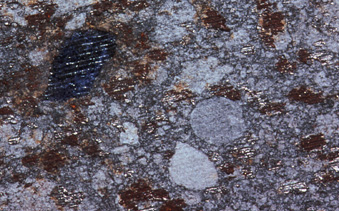geotimesheader
News
Notes
Astrogeochemistry
Briny beginning
A salt-containing meteorite that fell in Morocco
in 1998 may contain the oldest mineral ever discovered in our solar system,
providing a glimpse into a short period of time during which water existed
in the asteroid belt 4.571 billion years ago.
“Quite amazing,” is how James Whitby of the University
of Manchester, describes the discovery of halite crystals with water-bearing
fluid inclusions in the chondrite Zag (H3-6). He believes the salt formed
by the evaporation of mineral-rich water within 2 million years of the
age of the oldest known solar system minerals. Whitby and his colleagues
published their work in the June 9 Science. “I think at the moment
we’ve got the oldest mineral on Earth,” Whitby says, in light of recent
work by Charles Hohenberg at the University of Washington in St. Louis.
Magnetite from the Murchison meteorite held the honor of being the oldest
mineral ever discovered until Hohenberg recalculated its age and found
it to be younger than was previously thought.
Scientists believe that the Zag meteorite was
part of one of the large asteroids that provided building material for
planets. Whitby believes that the fragment under study broke off its parent
body approximately 4 million years ago. If the halite did indeed precipitate
from Zag’s short-lived hydrothermal system it would indicate that water
existed at least once in the earliest years of the solar system. “Nobody
has found water as such in these things before,” he says. The only prior
evidence of water has been from aqueous alteration that can occur when
extraterrestrial minerals are contaminated with water from Earth.
Nearly all of the xenon found in Zag’s halite
crystals is the isotope xenon-129. This fact, paired with the absence of
xenon-132, supports the argument that the xenon was not carried from some
other source by contaminant water. If the mineralized water that precipitated
the salt had remobilized xenon on Earth, it would most likely have contained
more xenon-132.
| Whitby recognized the halite as unusual right
away by its discoloration from radiation that would not likely have occurred
on Earth. To be sure that the halite was of extraterrestrial origin he
turned to radioisotope dating.
Isotopic analysis of a small sample of the halite
revealed an abundance of pure xenon-129, the radioactive decay product
of iodine-129. Iodine-129 is known to have existed in the early solar system,
but is no longer found on Earth. It has a half-life of 15.7 million years
and can only be used to date very old minerals from the first 100 million
years of the solar system’s existence, according to Whitby. Using relative
age dating, he and his colleagues estimated that the crystals formed 4.57
billion years ago — the commonly accepted age of Earth is 4.56 billion
years. Since these results were published in June, Whitby and his colleagues
calculated the absolute age of the halite using data from Hohenberg’s research
to give the chondrite an age of 4.571 billion years. |

Enlarged
photograph of the Zag meteorite. The scratches are saw marks
from
the preparation of the slice. The halite is purple due to radiation
damage
during its long history. This slice is held by the Natural History
Museum,
London. John Bridges, Natural History Museum, London. |
To explain how water may have come to exist so
early in the solar system’s history, Whitby offers a relatively simple
explanation. Imagine a planetary body at the dawn of the solar system.
It might have been as few as 10 kilometers in diameter, its interior heating
up from the radioactive decay of minerals such as aluminum-26. The internal
heat and pressure may have created the ideal conditions to form a transitory
period in which liquid water existed for a geologic blink of an eye.
While Whitby and his team aren’t searching for
extraterrestrial life, these findings provide a glimmer of hope for those
who are. “Wherever you have liquid water, the common view is that life
is soon to follow,” Whitby says. “It would have to be quick though, because
water couldn’t have existed [on Zag] for very long.”
Laura Wright

